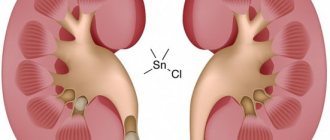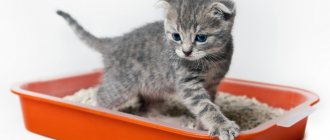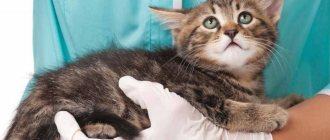11420Administration
2
Sometimes an owner is faced with the fact that his beloved cat is limping on his hind leg. There are many reasons for this phenomenon, and it is important to determine exactly what caused the lameness. A sick animal tries not to put any strain on its paw, almost never steps on it, and falls heavily when walking. The cat stops running, climbing trees, jumping through cabinets because it experiences pain and discomfort when moving and putting stress on the affected limb. It is necessary that the treatment is carried out correctly and the disease does not become chronic. If, in addition to lameness, the owner notices that bald spots are forming between the hind legs, contacting a veterinarian should be urgent. In some cases, lameness is an indicator of an emergency condition.
Sometimes an owner is faced with the fact that his beloved cat is limping on his hind leg. There are many reasons for this phenomenon, and it is important to determine exactly what caused the lameness. A sick animal tries not to put any strain on its paw, almost never steps on it, and falls heavily when walking. The cat stops running, climbing trees, jumping through cabinets because it experiences pain and discomfort when moving and putting stress on the affected limb. It is necessary that the treatment is carried out correctly and the disease does not become chronic. If, in addition to lameness, the owner notices that bald spots are forming between the hind legs, contacting a veterinarian should be urgent. In some cases, lameness is an indicator of an emergency condition.
© shutterstock
Why does a cat limp on his front leg: injury
As already mentioned, it is for this reason that a cat begins to limp on its paw most often. If the owners notice that it is difficult for their pet to step on its front paw, they should simply remember if anything has happened recently that could cause the injury. A cat may limp, for example, after an unsuccessful jump. Also, an animal’s paw may begin to hurt after someone steps on it, pinches it in a door, etc. In addition, quite often a similar problem is observed in those cats that are allowed to walk outside. A pet can get injured from other animals, after an unsuccessful jump, etc.
Lameness due to injury can range from mild to severe. In any case, if such a problem is discovered, your pet should be examined first. If the lameness is caused by an injury, a wound or swelling will likely be found on the paw. In this case, the animal owner should just wait a day. Most likely, the cat's injury, if he can still step on his paw, will go away after this time.
If the cat does not stop limping after 24 hours, you should take him to the veterinarian. The doctor will examine the animal, make the correct diagnosis and prescribe treatment.
The reasons why the cat began to limp on its front leg could be:
- cuts and punctures;
- fractures and dislocations;
- splinters.
Also, a cat, for example, can break a claw if it jumps unsuccessfully. In this case, the animal will subsequently experience quite severe pain for a long time and, accordingly, will begin to limp.
How to recognize a fracture or bruise
An injury to the paw always becomes immediately noticeable.
The cat holds the injured limb suspended, cannot step on it, and does not allow anyone to touch the sore spot.
A common type of injury in active cats is bruises. Distinctive signs of such damage are:
- swelling of the paw
at the site of the bruise; - hematoma
, which can be seen under the fur; - absence of wounds on the sore paw;
- the structure of the paw is not damaged;
- joints are mobile;
-
skin temperature is felt at the site of injury - The cat constantly licks the sore spot
.
A fracture is a more serious injury. Its signs are more pronounced and noticeable:
- violation of the shape
of the damaged paw; - bone instability can be determined by touch;
- swelling
in the entire paw.
Arthritis and arthrosis
This problem usually occurs in fairly old animals. In this case, lameness, of course, does not appear suddenly. At first, it becomes only slightly difficult for the pet to step on its foot. Then the problem gets worse.
If a cat has arthritis and is limping on its front leg, what should you do in this case? If there is such a problem, your pet will need to be shown to a specialist. Unfortunately, it is almost impossible to cure arthritis or arthrosis in old animals. The doctor will most likely prescribe only maintenance therapy.
Treatment
Treatment can be as simple as limited mobility for a few days for a minor tendon or ligament sprain, or as complex as orthopedic or neurological surgery.
Sometimes the exact cause of lameness may not be identified. In such cases, a period of limited mobility, possibly with anti-inflammatory treatment, may be recommended to see if the lameness responds to this conservative approach.
Surgery will almost always require postoperative hospitalization and the use of pain medications for a smooth and comfortable recovery. The length of hospital stay and the need for intensive care depend on the severity of the cat's condition, the severity of the problem, and the extent of surgery.
Elbow dysplasia
This disease occurs in both young and old cats. Unfortunately, purebred animals are especially susceptible to it. Cattery owners often use this method of breeding expensive cats as inbreeding. In this case, kittens are born with pronounced breed characteristics. However, inbreeding significantly increases the risk of offspring developing hereditary diseases. One of these ailments is elbow dysplasia.
Signs of this disease can appear in a pet at a very early age. However, lameness in a cat with this problem becomes most noticeable at 2-3 years of age. Of course, such animals should not be allowed to breed. Also, the cat should definitely be taken to the veterinarian.
Like arthrosis, it is unlikely that it will be possible to cure dysplasia in a pet. However, the doctor will still choose a treatment regimen that will make the cat’s life more comfortable. The main symptoms of this disease in cats, in addition to lameness, are:
- crunching sounds when moving;
- X-shaped curvature of the limbs;
- stiffness of movement when standing up.
Diagnosis of cat lameness
What to do if you find a cat with lameness on the front or back leg? First, do not delay visiting a veterinary clinic or office. If the cause is an infectious disease, then delay in treatment can cost not only the animal’s health, but also its life. During the visit, the veterinarian will perform the following diagnostic measures:
- will look at the patient's medical history (if any). He will conduct a survey of the owner, find out whether the animal has had any injuries recently, and find out about the presence of accompanying symptoms, in addition to lameness;
- visual inspection of a limping cat. It is necessary to understand how serious the lameness is, the location of the most painful area of the limb, and the presence of abnormal places in the structure of the joints. The doctor will look at how the animal moves, runs, stands;
- neurological examination. It is carried out to exclude damage to the central nervous system, muscles, brain or spinal cord, because lameness is not always caused by orthopedic problems;
- radiograph. It will help you see the presence of cracks, tumors, growths and other problems inside the limb.
You may also need to take tests of synovial fluid, general blood and biopsy, and urine. With the introduction of the dye, studies of the spinal canal are performed - myelography. Contrast radiography or arthrography (injection of dye into the joint) is done using the same method. Ultrasound, MRI and CT may be prescribed.
The cat will get an x-ray at the veterinary clinic.
Osteomyelitis in cats
If a domestic cat is limping on its front leg, this may also indicate that it has developed this dangerous disease. The disease in this case also manifests itself gradually. Osteomyelitis is a disease associated with bone necrosis, accompanied by a purulent-inflammatory process.
Most often, this unpleasant disease occurs in cats under the age of 2 years. At the same time, pets of the Persian breed are considered the most susceptible to it. Veterinarians explain this by hereditary predisposition. Osteomyelitis is usually treated comprehensively - through surgery, as well as medications.
Diseases of the joints and bones
Diseases that affect a cat's joints are often age-related and occur after 6-8 years of life. Some pathologies are congenital and develop gradually; more than a month may pass before the first symptoms appear. Viral diseases and various infections often serve as the impetus for the development of inflammation of joint tissues. If a cat has lameness, the following diseases are possible:
- 1. Hip dysplasia. A genetic abnormality that an animal suffers from birth or has a predisposition to develop. It progresses even at a young age. Lameness in an animal is most noticeable after sleep or rest. When a pet “develops” its limbs after a long period of rest, the symptom is not very pronounced or becomes almost invisible.
- 2. Arthritis and arthrosis. These diseases in most cases occur in older cats and are the most common pathologies affecting the joints. Changes in tissues in both diseases are largely similar, as are the symptoms of their manifestation. The animal tries to move as little as possible - this way the pain practically goes away. The cat refuses to eat and becomes weaker, and sometimes there is a rise in body temperature. Swelling occurs in the joint area, the animal reacts aggressively to palpation, and a local increase in body temperature is felt.
- 3. Patella or luxation of the kneecap. The pathology is rare and is caused by genetic abnormalities or severe trauma. The disease manifests itself abruptly: the animal suddenly begins to limp, it experiences severe pain, to which the cat reacts by meowing and hissing. Treatment is required as soon as possible, since with further development of the disease, surgical intervention will become necessary.
- 4. Osteomyelitis. The disease most often occurs in cats at a young age during the period of active growth. It is characterized by the process of degeneration of bone tissue and its partial destruction, affecting both one limb and several at once. The disease causes severe pain, so the pet does not allow the affected paws to be touched.
- 5. Osteochondrosis. A disease of the spine, as a result of which the spinal roots are pinched or pinched, causing the cat to lame in various limbs. A failure in the formation of cartilage tissue leads to the abrasion of the cartilage layer between the vertebrae, which causes severe pain when moving. A cat sometimes not only limps on its hind leg, but also pulls it back.
- 6. Osteosarcoma. A malignant formation that occurs in bone tissue. Most often it affects animals over the age of 6 years.
All these diseases are serious and require timely treatment under the supervision of a specialist. Typically therapy consists of painkillers and corticosteroids. In severe cases, surgery is required. If you suspect that your cat is limping due to any of the listed joint diseases, you should immediately contact a veterinary clinic. At home, you can only waste time without proper treatment.
In addition to medications, the animal needs constant rest, balanced food or a special diet, which will be prescribed by a specialist, who will also give all other recommendations.
Lameness due to infection
If the cat begins to limp on its front leg, it may have become infected with calcivirus. This disease of an infectious nature is very easily transmitted from a sick animal to a healthy one. For prevention, many cat owners vaccinate them against this disease. Animals that have not been vaccinated can become ill with calcivirus very easily.
In addition to lameness, signs of this disease may include:
- breathing problems;
- conjunctivitis;
- nasal discharge;
- damage to the paw joints;
- the presence of ulcers on the mucous membranes.
This disease causes inflammation of the anterior joint chambers. This is why the cat is limping on his front leg. What should owners do in this case? If you have calcivirosis, the animal should, of course, be shown to a specialist. Treatment in this case is complex - therapeutic and symptomatic.
Another infection that can cause lameness in a cat is a fungus. In this case, dermatophytes often affect not only the animal’s pads or its skin, but also its claws or joints. Lameness in cats in this case develops due to inflammation.
Pretense
Sometimes it happens that the animal has no visible injuries, but the cat still limps on its front leg. The reason in this case may simply be the nature of the animal. A pet whose paw is slightly pinched or, for example, stepped on, may be offended. In this case, the cat, even if it does not feel any discomfort in its paw, begins to limping demonstratively only in order to express its indignation to its owners.
If the lameness is simply emotional, there will most likely be no damage to the animal's paw. Moreover, after a couple of hours the cat will get tired of playing, and he will stop limping.
Prevention of lameness
Some cats, due to their natural predisposition, may suffer from lameness. Proper maintenance of the cat can avoid its occurrence or at least reduce the intensity of its manifestations: protect it from injury, adjust the diet, adding more foods with calcium and vitamins.
If you want to know whether a kitten will limp in the future, study its pedigree. Perhaps this is due to heredity and does not pose a danger to the health and life of the animal.
Cats that have crossed the border of old age, as a rule, move little and therefore begin to limp due to atrophy of the limbs. Play with them more often, provoking them to take active actions.
To prevent splinters from getting into your paws, do not be lazy to clean the room as thoroughly as possible, making sure that there are no objects lying on the floor that are potentially dangerous to the animal.
Lameness in cats is not that uncommon. If nothing else bothers your pet except it, then it is quite possible that in a couple of days the situation will return to normal. If you see that the cat has become restless and has been limping for a long time, then professional help is required.
In what cases should a cat be taken to the veterinarian?
When is specialist help needed? When the animal exhibits at least one of the following symptoms:
- the cat cannot walk at all or moves with great difficulty;
- when you touch the paw, the pet meows and abruptly pulls it away;
- the cat does not step on its paw, tucking it in when moving.
It is also worth visiting a specialist if the cat’s lameness is accompanied by loss of appetite, high fever, increased fatigue, lethargy or aggression. These are already very alarming symptoms.
The cat is limping on his front leg. What to do in this case, how to provide first aid to your pet?
As already mentioned, a limping animal should be left alone for one day and then taken to a veterinarian. Also, if a bruise is revealed during examination, you can apply cold to the affected area for 1 minute, wait 20 seconds and apply again for 1 minute. This operation should be repeated for 5 minutes.
If the owners suspect that the cat has a fracture, he needs to try to fix the paw. In this case, the animal must be taken to the clinic in an immobilized state. You can also try to provide first aid to a cat if he has a minor wound. In this case, the affected area must be carefully cleaned from dirt with a cloth soaked in soapy water. After this, the wound should be treated with furatsilin solution and the animal should be taken to the veterinarian.










